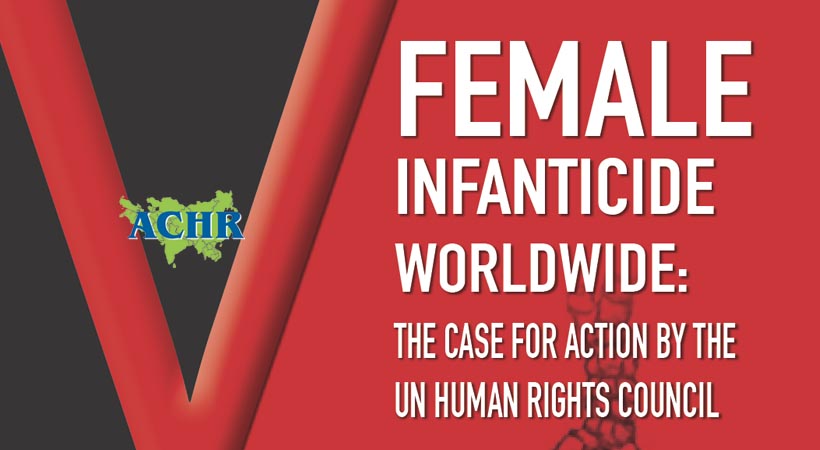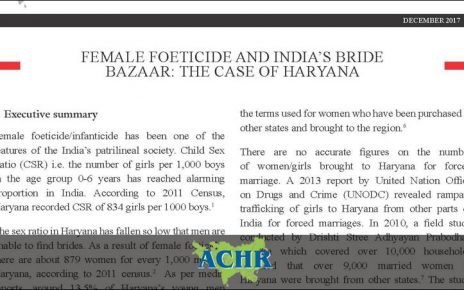“Our mental illness is responsible for this poor sex ratio. We give a lot of importance to boys. Many women also do this. But for how long will we look at girls as ‘paraya dhan’? [some other’s property] For every 1,000 boys born, 1,000 girls should also be born. I want to ask you if girls are not born, where will you get your daughters-in-law from?” -Narendra Modi, Prime Minister of India while launching “Beti Bachao-Beti Padhao” (Save girl child, educate girl child) campaign at Panipat in Haryana, 22 January 2015.
Female infanticide was practiced by many patrilineal societies of every continent. The son preference over daughter has been rooted in various social norms of most patrilineal societies such as inheritance passing on to male offspring, male offspring providing economic support and security in old age and performing death rites. The policy of restricting the number of children a couple can have for population control in China only provided impetus for son preference while dowry system in South Asia made daughters an unaffordable economic burden and hence further contributed to son preference. The increased pressure on smaller families to fulfill their wish for a son has also been contributing to female infanticide.
The invention of technology i.e. ultrasonography for pre-natal sex determination in 1980s replaced intentional killing of infant girls with sex selective abortion of female foetuses. Since 1990s various studies recognised female infanticide as a serious problem with reduction of women in comparison to men.
The collusion of technology and traditions created monumental problem for the humanity with reports of millions of missing girls through female infanticide. The United Nations in 2007 estimated that between 113 million and 200 million girls/women are demographically “missing” across the globe and the number has increased with more than 117 million girls/women “missing” in Asia alone due to sex selective abortions as per latest information provided by the United Nations Population Fund (UNFPA) in its website. The Population Reference Bureau estimates that every year 1.5 million girls go missing at birth”.
Biologically, normal sex ratio at birth (SRB) varies from 102 to 106 males per 100 females. But the SRB has increased sharply in favour of males due to sex selective abortions of female foetus due to son preference in the family. The highest SRB was found in Liechtenstein (126 boys born per 100 girls born) in 2012 followed by China (117.8) in 201111, Azerbaijan (115.6) in 2013, Armenia (114.8) in 2013, Viet Nam (112.2) in 2014, Georgia (111.8) in 2013, Albania (110.9) in 2012, India (110.5) during 2008-10, Pakistan (109.9) in 2007, Tunisia (107) in 2014, Nigeria (106) in 2014, Nepal (106) in 2011, and Republic of Korea i.e. South Korea (105.3) in 2013.
As per The World Factbook 2016 of the Central Intelligence Agency (CIA) of the United States, the countries with the most skewed sex ratio at birth can be ranked as follows:
Table 1: Ranking of the countries based on skewed sex ratio at birth
| Rank | Name of the country | Sex ratio at birth |
| No.1 | Liechtenstein | 126 males/100 females |
| No.2 | China | 115 males/100 female |
| No.3 | Armenia | 113 males/100 females |
| No.4 | India | 112 males/100 females |
| No.5 | Azerbaijan | 111 males/100 females |
| No.5 | Viet Nam | 111 males/100 females |
| No.6 | Albania | 110 males/ 100 females |
| No.7 | Georgia | 108 males/100 females |
| No.8 | South Korea | 107 males/100 females |
| No.8 | Tunisia | 107 males/ 100 females |
| No.9 | Nigeria | 106 males/ 100 female |
| No.10 | Pakistan | 105 males/100 females |
| No.11 | Nepal | 104 males/ 100 females |
The growing surplus of men has dire consequences for the human race, among others for causing trafficking of girls/women in the areas having shortage of women and these trafficked girls/women facing violence and discrimination.
A number of governments have been taking measures to address selective abortion of female foetuses. Several laws in China namely the Law of the People’s Republic of China on Maternal and Infant Health Care of 1994, Regulations on Administration of Technical Services for Family Planning of 2001 and the Population and Family Planning Law of the People’s Republic of China of 2002 prohibit sex identification of the foetus and sex selective abortions. In India, the Pre-conception and Prenatal Diagnostic Techniques (Prohibition of Sex Selection) Act, 1994 (amended in 2003) prohibits sex-selection or disclosure of the sex of the foetus “by words, signs or in any other manner” and prohibits sale of “any ultrasound machine or imaging machine or scanner or any other equipment capable of detecting sex of foetus” to persons, laboratories, clinics, etc. not registered under the Act. Further, India’s Medical Termination of Pregnancy (MTP) Act of 1971 (amended in 2002) allows abortion only up to 20 weeks for an unintended pregnancy (such as due to rape, incest, failure of family planning etc) based on the opinions of two registered medical practitioners but abortion is allowed at any time if it is necessary to save the life of the pregnant woman/girl. In 2002, Nepal amended the Country Code, Muluki Ain, to allow abortion on medical grounds but prohibited sex selective abortions. The Population Ordinance (2006) and Prime Minister Decree (2006) of Viet Nam prohibit all practices of antenatal foetal sex diagnosis and sex selection. A number of countries such as Armenia and Azerbaijan have been debating legal measures to ban sex selective abortions.
However, these measures of the governments have not been fully successful because of the easy access to ultrasonography and weak law enforcement. In China, ultrasound for pre-natal determination of sex can be done for as low as £245 while entire ultrasound-plus-abortion package is available for about US$150 in India.
Further, “reproductive tourism” for the purposes of sex selection through In Vitro Fertilization (IVF) and other new technologies such as Pre-Implantation Genetic Diagnosis (PGD), Pre-Implantation Genetic Screening (PGS) and sperm-sorting has been emerging as the next challenge of female infanticide. In Thailand where sex selection is not illegal, the Chinese, Indians, and the Eastern Europeans account for over 70-80% of those preferring PGD while the Asian Law Institute found that over 80% of PGD practices were undertaken for the purpose of sex selection, not for any medical purpose.
The UN adopted the Sustainable Development Goals (SDGs) on 25 September 2015 and Goal 5 of SDGs is to “achieve gender equality and empower all women and girls”. The SDG-5 has identified nine targets but fails to specifically refer to sex selective abortion as one of the harmful practices.
There is an urgent need to mobilise the UN, other multilateral organisations and the member States of the UN for more proactive actions to address the menace of the “missing girls” worldwide. The UN Human Rights Council (UNHRC) should adopt a resolution, interalia, to ensure that the issue of female infanticide is given due attention in the work of all human rights mechanisms including the UN Human Rights Council and its relevant processes and mechanisms such as the Special Procedures and the Universal Periodic Review, the UN Treaty bodies etc. The resolution should mandate the United Nations High Commissioner for Human Rights to organize an expert workshop to review and discuss the impact of existing strategies and initiatives to address female infanticide and to make recommendations for further action by States and the international community towards the full implementation of human rights obligations with respect to female infanticide and prepare a report on the deliberations held during the workshop and submit it to the UNHRC which should consider inclusion of female infanticide as an agenda item of the UNHRC sessions.




